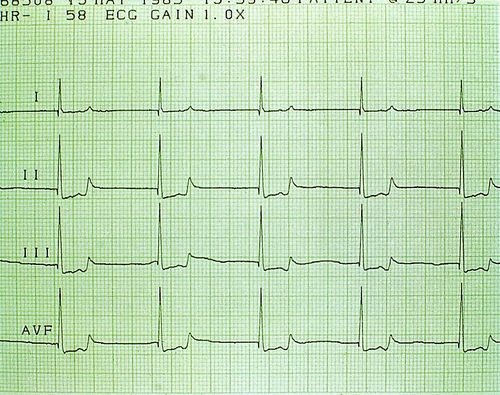Difference between revisions of "Small Animal Soft Tissue Surgery Q&A 08"
Ggaitskell (talk | contribs) |
|||
| (One intermediate revision by the same user not shown) | |||
| Line 1: | Line 1: | ||
| − | |||
| − | |||
| − | |||
| − | |||
[[File:SA ST Sx 08.jpg|centre|500px]] | [[File:SA ST Sx 08.jpg|centre|500px]] | ||
| Line 17: | Line 13: | ||
The features of atrial standstill are bradycardia (usually less than 60 bpm), absence of P waves in all leads and normal appearing QRS complexes initiated from a supraventricular focus. | The features of atrial standstill are bradycardia (usually less than 60 bpm), absence of P waves in all leads and normal appearing QRS complexes initiated from a supraventricular focus. | ||
| − | |l1= | + | |l1= |
|q2=What are the potential causes of this arrhythmia? | |q2=What are the potential causes of this arrhythmia? | ||
|a2= | |a2= | ||
| Line 27: | Line 23: | ||
These dogs demonstrate atrial standstill on ECG, but have normal electrolytes and the rate does not increase after the administration of atropine. | These dogs demonstrate atrial standstill on ECG, but have normal electrolytes and the rate does not increase after the administration of atropine. | ||
| − | |l2= | + | |l2= |
|q3=If this dogs electrolytes are normal, how would you treat it? | |q3=If this dogs electrolytes are normal, how would you treat it? | ||
|a3= | |a3= | ||
The treatment of choice is permanent ventricular pacemaker implantation. | The treatment of choice is permanent ventricular pacemaker implantation. | ||
| − | |l3= | + | |l3= |
</FlashCard> | </FlashCard> | ||
Revision as of 14:17, 29 September 2011
You are presented with a seven-year-old English Springer Spaniel with a history of exercise intolerance and ‘passing out’. On physical examination the dog is alert and active. On auscultation of the heart you determine that there is bradycardia (heart rate 55 bpm). The lead II electrocardiogram (ECG) you recorded for this patient is shown.
| Question | Answer | Article | |
| Name the arrhythmia and describe its features. | This ECG is consistent with atrial standstill. The features of atrial standstill are bradycardia (usually less than 60 bpm), absence of P waves in all leads and normal appearing QRS complexes initiated from a supraventricular focus. |
[[|Link to Article]] | |
| What are the potential causes of this arrhythmia? | Hyperkalemia associated with Addison’s disease, oliguric renal failure and obstructive uropathy can cause atrial standstill. Other rule outs include digitalis toxicity and persistent atrial standstill. Persistent atrial standstill occurs most commonly in English Springer Spaniels. Its etiology remains undetermined; however, an underlying muscular dystrophy has been described in some dogs with persistent atrial standstill. These dogs demonstrate atrial standstill on ECG, but have normal electrolytes and the rate does not increase after the administration of atropine. |
[[|Link to Article]] | |
| If this dogs electrolytes are normal, how would you treat it? | The treatment of choice is permanent ventricular pacemaker implantation. |
[[|Link to Article]] | |
